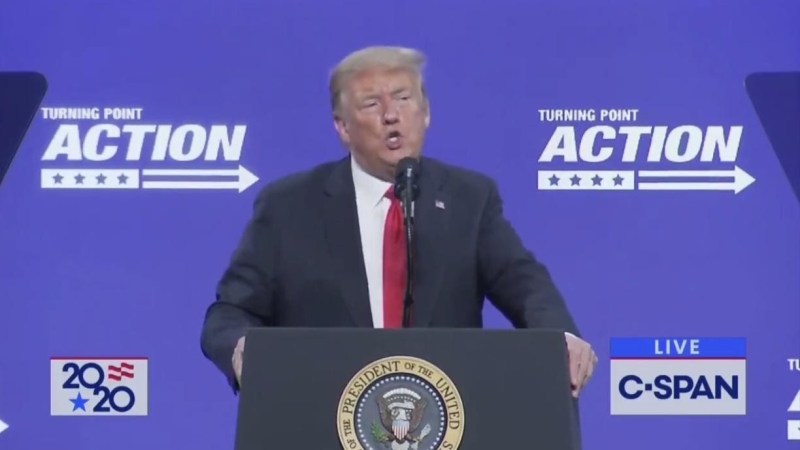President Trump called on the nation’s students to engage in the “tremendous intellectual struggle for the future of our country” in a speech broadcast live to the nation last Tuesday from Dream City Church in Phoenix, Arizona. While the country confronts the stark reality of the present, the Trump campaign faces an equally challenging task in securing the youth vote amidst the profound demographic changes underway.
The post-COVID-19 presidential campaign officially began last weekend in Tulsa, Oklahoma. A state with deep red history, Oklahoma has been carried by a Republican every presidential election year since 1968, which marked the end of the formidable New Deal coalition that had dominated politics since 1932. Borrowing straight from the political playbook of Richard Nixon in the sixties, Trump is hoping to secure the vote of his own 2020 Silent Majority, and Tulsa was ground-zero for the voter demographic in which the campaign will likely be investing to drive turnout.
There is something different about the so-called Silent Majority of the present, which consists mostly of his base and a portion of the electorate he calls “patriots.” Arizona’s fate is similar to many other swing states, places where shifting demographics will determine political destiny. Interestingly, the Trump campaign is focusing its efforts on a voting bloc many have written off as decisively progressive: the youth vote.
Known for their progressive bent (as shown below), Gen-Z and Millennials are poised to be the most decisive voting blocs by 2039. They are already influencing the political process in numerous ways. The Students for Trump convention is Trump’s attempt to secure a coalition of both present and future voters who are in the midst of finding their political homes.
Source: Ferguson, Niall. Freyman, Eyck. (2019). Projected share of registered voters identifying or leaning Democratic, by generation, assuming constant levels of party identification [bar chart]. The Atlantic. Available/Retrieved from: https://www.theatlantic.com/ideas/archive/2019/05/coming-generation-war/588670/
The president has enormous influence over the hearts and minds of every generation under his leadership, and he can shape the boundaries of partisan identities by virtue of the decisions he makes in office. President Obama infamously used executive orders on immigration to help shape partisan attitudes and improve his approval rating. Issuing executive orders changed his standing with different portions of the electorate. When great shocks in history occur, a president can influence the political attitudes of entire voting blocs — turning them either in his favor or not.
By hosting a convention dedicated solely to students, Trump is attempting to shift a generation’s mindset in his favor. However, with students showing such a liberal bent, and given the prevalence of Black Lives Matter protests, which have been dominated by youth, can the president secure the votes of a generation desperate for a political voice?
If Trump is to make any inroads in this disparate voter bloc, he must change course from his strategy in 2016. It was once to solidify turnout from members of the Silent Generation, who had taken a hard turn to the right during the Obama years and stayed in that state (see below). The 2017 tax cuts were an effort to shore up this base for future political prospects. It is no longer the case that the Silent Generation can carry Trump’s campaign; to win the favor of young voters, the GOP will have to revise its platform.
Gen-Z and Millennial Republicans have a much different view on the role of government in the economy. Gen-Z Republicans are four times as likely as Silent Generation Republicans to hold the view that the government should play a more significant role in citizens’ lives. As the Silent Generation’s share of the electorate decreases and is supplanted by younger Republicans, the very definition of conservatism will also evolve. Perhaps the era of big-government GOP is here — or will be soon.
Source: Ferguson, Niall. Freyman, Eyck. (2019). Projected share of registered voters identifying or leaning Democratic, by generation, assuming constant levels of party identification [bar chart]. The Atlantic. Available/Retrieved from: https://www.theatlantic.com/ideas/archive/2019/05/coming-generation-war/588670/
At the student convention, Trump experimented with the type of rhetoric that usually secures him votes from more mature populations. He emphasized his efforts to cut taxes and promote deregulation, saying that “by a factor of many times… Nobody has cut regulation like we have.” To a generation that has seen, in large part, a failure of traditional institutions, it will take much more than tax cuts to win over their vote. If the GOP hopes to have students join the “tremendous intellectual struggle” of our times, it’ll need to do a bit of soul searching to attract the votes of youth who are distinct from their typical base.
Contact Chaze Vinci at cvinci ‘at’ stanford.edu.
The Daily is committed to publishing a diversity of op-eds and letters to the editor. We’d love to hear your thoughts. Email letters to the editor to eic ‘at’ stanforddaily.com and op-ed submissions to opinions ‘at’ stanforddaily.com.
